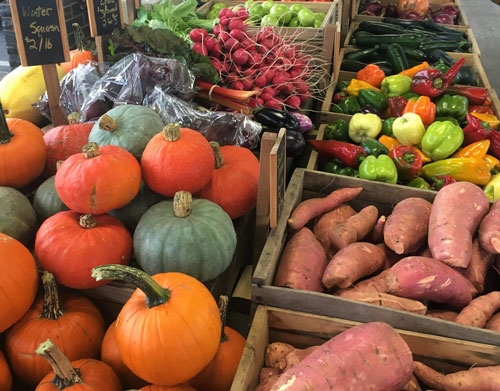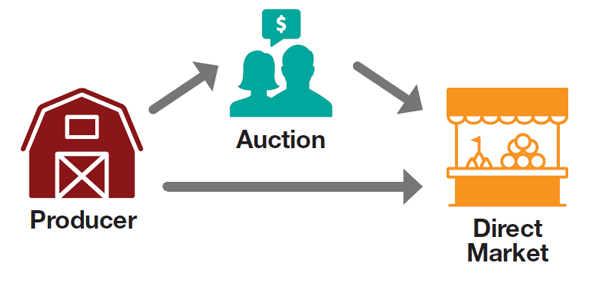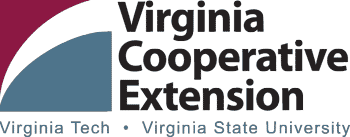Accessing Virginia’s Markets: Direct-to-Consumer
- Introduction
- Examples of Direct-to-Consumer Markets
- Survey Findings
- Purchasing Priorities & Barriers
- Recommendations
- Producer Checklist
- Helpful Resources
Introduction
 Communicating directly to consumers is one of the most effective ways to advertise your business operation. Fortunately, consumer interest in locally produced foods marketed directly through local food networks has been increasing. In a direct market that revolves around food procurement, producers and consumers interact (you guessed it) directly. But what does this look like? Local food networks utilize local supply chains such as direct market sales to consumers through CSAs, agritourism, farmers markets, farm stands, and other alternative outlets (see below). Additionally, the direct market sector offers feedback far more quickly than most other sectors, and is therefore a great choice for any beginning growers looking to get their feet wet and experiment. It’s important to note, however, that as food safety laws continue to develop along with the general public’s concerns with food safety, it is profoundly important that the local growers intending on selling directly in this sector familiarize themselves with current food safety practices, laws, and regulations.
Communicating directly to consumers is one of the most effective ways to advertise your business operation. Fortunately, consumer interest in locally produced foods marketed directly through local food networks has been increasing. In a direct market that revolves around food procurement, producers and consumers interact (you guessed it) directly. But what does this look like? Local food networks utilize local supply chains such as direct market sales to consumers through CSAs, agritourism, farmers markets, farm stands, and other alternative outlets (see below). Additionally, the direct market sector offers feedback far more quickly than most other sectors, and is therefore a great choice for any beginning growers looking to get their feet wet and experiment. It’s important to note, however, that as food safety laws continue to develop along with the general public’s concerns with food safety, it is profoundly important that the local growers intending on selling directly in this sector familiarize themselves with current food safety practices, laws, and regulations.
Using a farmers market for example, though it seems simpler than going through a large contractor, still has its requirements. Farmers markets help sustain Virginia’s working farms by keeping your food dollars in your community, which in turn is good for your local economy. While this is exciting and a great market to be apart of, you may need to comply with state and local laws, health department certifications, insurance regulations, business license requirements, and individual market rules and conventions. You should anticipate that you will be told exactly how you can operate, which may include how you should package and label your produce, ensuring customer safety, providing samples, and participating in market events. Additionally, to give you an estimate on operating costs, for farmers markets they are usually lower than a retail storefront, but higher than street vending. Many farmers markets charge a flat fee anywhere from $20 to $100 per day, and much higher in some markets (usually urban markets are higher). A plus side to selling at a farmers market however is that since you are providing “fresher” ingredients locally, you can factor transportation costs out of your expenses (mainly shipping costs, you of course have to consider driving to and from market).
There is also a large diversity of product and niche markets that farmers markets provide, which is a main reason why they draw in so many people. Note that all farmers markets are not the same; entering to sell in a rural market will be very different than entering to sell in an urban market. Many of the pros and cons to farmers markets apply to other direct markets as well, including that fact that you are the sole operator, meaning you don’t have to worry about having an integrated format in your supply chain. In Virginia, there are about 235 farmers markets to choose from, so there are plenty of opportunities to enter the market!
Examples of Direct-to-Consumer Markets
- Farmers markets operate year round or seasonally as a venue for farmers to sell their fresh fruits and vegetables.
- Roadside markets are often located on a farm or orchard. Products are typically sold
directly to consumers near the farm roadway. They may be operated from a year-round permanent structure, a truck, trailer, or tent during the harvest period. - On-farm stores are located in a permanent structure on the farmer’s property. May
operate year-round, and are subject to more regulations than a roadside stand. - PYOs or U-pick operations are places where consumers harvest fruits and vegetables
themselves. - Community Supported Agriculture (CSA) members or “share holders” cover the costs of the community farm operation and in return they receive shares of the seasonal foods throughout the farming season.
- Other: Mail order sales and internet marketing, mobile markets
Survey Findings
This sector was more robustly represented through our surveys with nine respondents. While within this market it is easier to bypass typical regulation seen in most other markets, there is also a smaller chance for a larger profit for the grower. This is simply due to the number of actual buyers and the given competition that comes in most direct-to-consumer markets, as well as the likelihood that these buyers are procuring for a limited number of people. It is important to note that the findings in this survey reflected the fact that some respondents were buyers of product, as well as producers. One respondent reported that they require a third-party food safety audit from growers/vendors. Five respondents were familiar with the Food Safety Modernization Act (FSMA), but were not sure how it affects their organizations. With the advancement of food safety legislation, as well as increasing public awareness of food safety concerns, it would behoove the local growers that intend on selling direct to familiarize themselves with current food safety practices.
Purchasing Priorities & Barriers
Priorities
- Quality
- Availability
- Product Variety and Diversity
- Proximity of Producer to Buyer
- Delivery Capabilities
Barriers
- Insufficient Volume of Product
- Grower Lack of Understanding of Buyer Requirements
- Lack of Variety/ Product Diversity
- Product Consistency
- Cost of Product
- Delivery Timing, Flexibility, etc.
- Several respondents suggested creating a statewide system that connects farmers, producers, and suppliers. The Virginia Market Maker was recently established as part of the national Market Maker program. Tap into this valuable resource as a way to promote your business (see resources).
- Consider using season extension as a way to offer a more consistent supply of product, and also as a way to provide more niche products.
- Recognize that selling to direct markets can often lead to other opportunities, including scaling up to larger markets. Having a simple written food safety plan and practices in place is important to demonstrate your awareness of the importance of food safety and a commitment to produce quality and freshness. It also makes it easier if you need to pursue a food safety certification.
- “It [would] be nice to have across the board standards for all growers. They are all selling to the public no matter if it's famers markets or school systems, so safety needs to be a number one concern.”
- “Our biggest barrier is quantity, especially for some types of produce (berries).”
- “We don’t have any explicit food safety requirements. We want to make sure we know which product came from which farmer, but right now we can just do that through our invoicing system...The aggregator we work with had food safety requirements for all the farms they work with. And all the other farmers we work with, we have a long, personal relationship with them.”
- Have you contacted the manager of the market you are interested in selling at?
- Have you studied vendor rules and regulations of the market so that you are aware of specific requirements you need to meet?
- Does the market require food safety training, documentation, and practices both on-farm and at the market? If so, how does the market verify adherence to their food safety rules?
- Have you attended any food safety training, and do you have a simple written food safety plan that may boost your marketability, as well as your credibility as a local producer?
- Have you considered logistical hurdles of selling your produce, such as handling practices, storage, transport, and holding at the market?

Direct Market Food Sales in Virginia
Direct market food sales information for Virginia growers.
Enhancing the Safety of Locally Grown Produce
A series of fact sheets providing an introduction to best practices in the cultivation, harvest, transport, and marketing of fresh produce. Companion training is available through Cooperative Extension.
Going to Market
A guide to selling raw, processed and prepared food products at farmers markets, stores & roadside stands in Virginia.
Virginia Department of Agriculture and Consumer Services
Farmers markets by region.
Virginia Market Maker
The Market Maker portal is the largest and most in-depth national database for the agricultural industry. The portal provides a simple search tool to connect buyers, farmers/ranchers, fisheries, farmers markets, processors/packers, wineries, restaurants and more.
